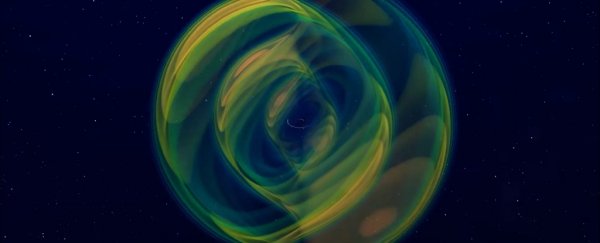Just over a year ago, on 12 April 2019, the LIGO-Virgo collaboration made a detection of gravitational waves, rippling out across space-time from the epic collision of two black holes from 2.4 billion light-years away. By now, marvellously, this is nothing out of the ordinary in and of itself.
But, as astronomers have now revealed, the actual GW 190412 collision was something we have never seen before. Rather than two roughly equal-mass black holes between 20 and 40 times the mass of the Sun, GW 190412 was produced by a wildly uneven binary.
Based on analysis of those rippling gravitational waves, astronomers have discovered that one of the black holes tipped the scales at around 29.7 solar masses, while the other was over three times smaller - just 8.4 solar masses.
This is also the lowest-mass black hole binary detected to date - which is tremendously exciting, because it means their merger produced a longer signal than any other black hole merger - a wealth of data to probe.
"Neither of these masses is too surprising on their own. We know black holes come in these sizes. What is new is the ratio of the masses," explained astronomer Christopher Berry of Northwestern University and the LIGO Collaboration in a blog post.
"This observation lets us test our predictions for gravitational wave signals in a new way, and is another piece in the puzzle of understanding how binary black holes form."
The Collaboration's findings were presented at the Virtual April Meeting of the American Physical Society.
Because other gravitational wave events have been generated by roughly equal-mass black hole binaries, this is reflected in the signal. Because the black holes are the same mass, they return to the same relative position with each orbit.
This results in a gravitational wave frequency that's around twice the orbital frequency of the binary system, that is, how long it takes the black holes to orbit each other. But when the system has a significant mass imbalance, the orbit is uneven. This produces a second, weaker gravitational wave frequency.
This was observed in GW 190412, which produced (among the family of chirps usually found in a black hole merger) two distinct frequencies, as though two guitar strings were vibrating simultaneously, a dyad of frequencies.
Amazingly, these frequencies were the equivalent of five notes apart - what is known as a perfect fifth. When you start singing Twinkle, Twinkle, Little Star, the first two twinkles constitute this musical interval.
As well as being really awesome, these frequencies allowed the team to perform yet another test of general relativity, too. Basically, they split the gravitational wave signal into an earlier part and a later part, and used equations based on general relativity to calculate the other part of the signal for each half.
The halves matched up with the calculations, producing some of the most robust results from this test to date.
Based on the merger's unusual signal, the team was able to make a few more measurements, too. They were able to determine that the larger of the black holes was spinning - usually quite a difficult thing to measure, and only achieved previously (and tentatively) in two other mergers.
In GW 190412, this spin seemed to be quite fast, which could be a clue as to how such an uneven binary came to exist. You see, there are several astrophysical models for the formation of black hole binaries, but most of them result in more-or-less equal-mass pairs.
The most obvious one is a binary star system in which each star collapses into a black hole. However, it's thought that these can't produce binary black holes with large mass discrepancies, ruling out GW 190412.
It's possible that the black holes formed separately, then somehow came together, capturing each other in orbit. But the high spin of the larger black hole suggests that it could have merged with other black holes previously, before GW 190412.
If the black holes were in a triple or quadruple system, it could be that the larger black hole had already merged with the others. If they were just floating around in normal space, the recoil kick from the merger would disrupt the system - but there's one scenario where it could work: in the disc around an active supermassive black hole at the heart of a galaxy.
There, the extreme gravitational environment could allow stellar-mass black holes to go through several successive mergers without being booted out by the recoil kick.
It's impossible to know for certain at this stage, but with the LIGO-Virgo collaboration making detections every few days, we may not have to wait too long for answers.
The dyad wasn't the only coincidence produced by GW 190412, by the way. The mass ratio between the two black holes is "roughly equal to the ratio of filling in a regular Oreo to in a Mega Stuf Oreo," Berry noted.
"Investigations of connections between Oreos and black hole formation are ongoing."
You can read the team's full paper on the LIGO website.
